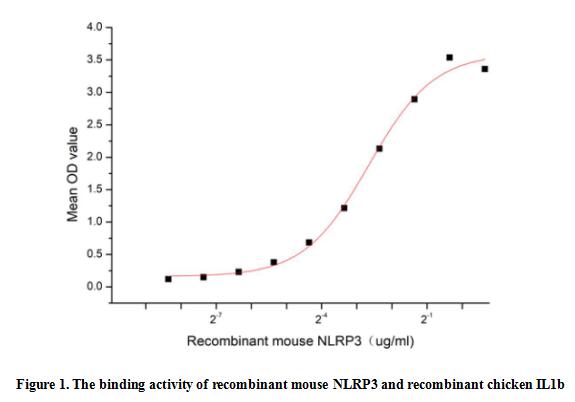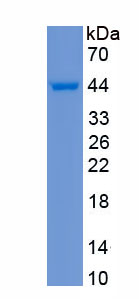Active NLR Family, Pyrin Domain Containing Protein 3 (NLRP3) 

AVP; AGTAVPRL; AII; AII/AVP; C1orf7; CIAS1; CLR1.1; FCAS; FCU; MWS; NALP3; PYPAF1; Cryopyrin; Cold Induced Autoinflammatory Syndrome 1; Caterpiller-Like Receptor 1.1
- UOM
- FOB US$ 276.00 US$ 690.00 US$ 1,380.00 US$ 4,140.00 US$ 10,350.00
- Quantity
Overview
Properties
- Product No.APK115Mu01
- Organism SpeciesMus musculus (Mouse) Same name, Different species.
- ApplicationsCell culture; Activity Assays.
Research use only - DownloadInstruction Manual
- CategorySignal transduction
- Buffer FormulationPBS, pH7.4, containing 0.01% SKL, 5% Trehalose.
- Traits Freeze-dried powder, Purity > 80%
- Isoelectric Point6.1
Sign into your account
Share a new citation as an author
Upload your experimental result
Review

Contact us
Please fill in the blank.
Activity test

NLR Family, Pyrin Domain Containing Protein 3 (NLRP3), also known as NALP3, CIAS1, PYPAF or Cryopyrin, is a cytosolic multiprotein complex composed of the innate immune receptor protein NLRP3, adapter protein ASC, and inflammatory protease caspase-1 that responds to microbial infection, endogenous danger signals, and environmental stimuli. Aberrant activation of the NLRP3 inflammasome is associated with the pathogenesis of various inflammatory diseases, such as diabetes, cancer, and Alzheimer‘s disease. Interleukin 1 Beta (IL1b) can interact with NLRP3, thus a functional binding ELISA assay was conducted to detect the interaction of recombinant mouse NLRP3 and recombinant chicken IL1b. Briefly, NLRP3 was diluted serially in PBS with 0.01% BSA (pH 7.4). Duplicate samples of 100 μl were then transferred to IL1b-coated microtiter wells and incubated for 1h at 37℃. Wells were washed with PBST and incubated for 1h with anti-NLRP3 pAb, then aspirated and washed 3 times. After incubation with HRP labelled secondary antibody for 1h at 37℃, wells were aspirated and washed 5 times. With the addition of substrate solution, wells were incubated 15-25 minutes at 37℃. Finally, add 50 µL stop solution to the wells and read at 450/630 nm immediately. The binding activity of recombinant mouse NLRP3 and recombinant chicken IL1b was shown in Figure 1, the EC50 for this effect is 0.16 ug/mL.
Usage
Reconstitute in 10mM PBS (pH7.4) to a concentration of 0.1-1.0 mg/mL. Do not vortex.
Storage
Avoid repeated freeze/thaw cycles. Store at 2-8°C for one month. Aliquot and store at -80°C for 12 months.
Stability
The thermal stability is described by the loss rate. The loss rate was determined by accelerated thermal degradation test, that is, incubate the protein at 37°C for 48h, and no obvious degradation and precipitation were observed. The loss rate is less than 5% within the expiration date under appropriate storage condition.
Increment services
-
 BCA Protein Quantification Kit
BCA Protein Quantification Kit
-
 Molecular Mass Marker for Protein
Molecular Mass Marker for Protein
-
 Monoclonal Antibody Customized Service
Monoclonal Antibody Customized Service
-
 Polyclonal Antibody Customized Service
Polyclonal Antibody Customized Service
-
 Protein Activity Test Experiment Service
Protein Activity Test Experiment Service
-
 Electrophoretic Mobility Shift Assay (EMSA) Experiment Service
Electrophoretic Mobility Shift Assay (EMSA) Experiment Service
-
 Buffer
Buffer
-
 Lentivirus Packaging Experiment Service
Lentivirus Packaging Experiment Service
-
 Adenovirus Packaging Experiment Service
Adenovirus Packaging Experiment Service
-
 Real Time PCR Experimental Service
Real Time PCR Experimental Service
-
 Spike RBD Protein (S-RBD)
Spike RBD Protein (S-RBD)
-
 Protein G
Protein G
-
 Protein A
Protein A
Citations
- Inflammatory Consequences of Maternal Diabetes on the Offspring Brain: a Hippocampal Organotypic Culture StudyPubmed: 31197747
- Anti-Inflammatory Effect of Cherry Extract Loaded in Polymeric Nanoparticles: Relevance of Particle Internalization in Endothelial CellsPubmed: 31569594
- Effect of combined periodontal-orthodontic treatment on NOD-like receptor protein 3 and high mobility group box-1 expressions in patients with periodontitis …Pubmed: 31689812
- Overektomize dişi sıçanlarda beyin oksidatif stres, bdnf ve inflamatuar cevap düzeyleri ile nörodavranışsal değişiklikler üzerine anjiyotensin II İnhibisyonunun etkisi







